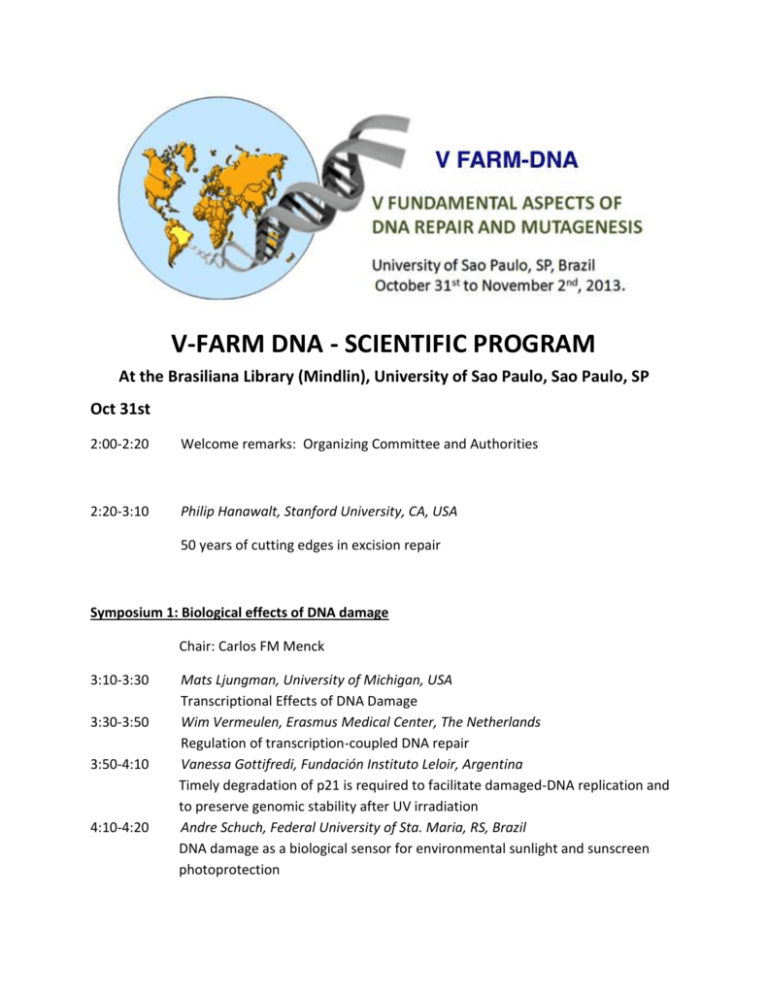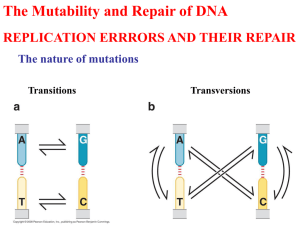here
advertisement

V-FARM DNA - SCIENTIFIC PROGRAM At the Brasiliana Library (Mindlin), University of Sao Paulo, Sao Paulo, SP Oct 31st 2:00-2:20 Welcome remarks: Organizing Committee and Authorities 2:20-3:10 Philip Hanawalt, Stanford University, CA, USA 50 years of cutting edges in excision repair Symposium 1: Biological effects of DNA damage Chair: Carlos FM Menck 3:10-3:30 3:30-3:50 3:50-4:10 4:10-4:20 Mats Ljungman, University of Michigan, USA Transcriptional Effects of DNA Damage Wim Vermeulen, Erasmus Medical Center, The Netherlands Regulation of transcription-coupled DNA repair Vanessa Gottifredi, Fundación Instituto Leloir, Argentina Timely degradation of p21 is required to facilitate damaged-DNA replication and to preserve genomic stability after UV irradiation Andre Schuch, Federal University of Sta. Maria, RS, Brazil DNA damage as a biological sensor for environmental sunlight and sunscreen photoprotection 4:20-4:50 Coffee Break Symposium 2: Human Syndromes and DNA repair defects Chair: Rodrigo Galhardo 4:50-5:10 5:10-5:30 5:30-5:50 5:50-6:10 6:10-6:30 6:30-6:40 7:00-10:00 Alan Lehmann: University of Sussex, UK The xeroderma pigmentosum population in the UK: unexpected phenotypes and relationships to molecular defects Priscilla Cooper, Lawrence Berkley National Laboratory, USA. XPG partners with BRCA1/2 in homologous recombination to maintain genome stability Graciela Spivak, Stanford University, CA, USA Cockayne and UV-sensitive syndrome cells are defective in transcription-coupled repair of 8-oxoguanine Alan Sarasin, University Paris-Sud and Institut Gustave Roussy, France Correlation of phenotype/genotype in a cohort of 23 xeroderma pigmentosumvariant patients reveals 13 new disease-causing POLH mutations Lisiane Meira, University of Surrey, UK When good things go bad: DNA repair driving cell death Jenifer Saffi, Federal University of Health Sciences, RS, Brazil DNA damage response and cytotoxicity of topoisomerase II inhibitors Welcome cocktail Nov 1st Symposium 3: New roles for old repair proteins Chair: João A. P. Henriques 8:30-8:50 8:50-9:10 Annette Larsen, Saint-Antoine Research Center, Paris, France BRCA2 is needed for both homologous recombination repair and cell cycle arrest in mammalian cells exposed to S23906, an anticancer monofunctional minor groove binder Pete McKinnon, St. Jude Children's Research Hospital, USA ATM, DNA Damage Signaling and Neurogenesis 9:10-9:30 9:30-9:50 Jean Sebastian Hoffmann, University of Toulouse, France Novel functions of the alternative DNA Polymerases during S-phase for the maintenance of genetic stability in human cells Tinna Stevnsner, Aarhus University, Denmark Protein interactions for Cockayne Syndrome group B (CSB) protein in Base Excision Repair (BER) 9:50-10:00 Lucymara F. Agnes-Lima, Federal University of Rio Grande do Norte,Brazil APE1 as a target for anti-inflammatory therapy 10:00-10:30 Coffee-break Symposium 4: Oxidative damage to nucleic acids Chair: Fabio L. Forti 10:30-10:50 10:50-11:10 11:10-11:30 11:30-11:50 11:50-12:10 12:10-2:00 Akihiko Nunomura, University of Yamanashi, Japan Oxidative RNA Damage and Repair Roger Woodgate, National Institutes of Health, USA Mechanisms of ribonucleotide repair in E. coli Evelyne Sage, Institut Curie, Paris, France Processing of clustered DNA lesions Rex Tyrrel, University of Bath, UK UVA as an oxidative stress : the disruption of iron and heme homeostasis versus restoration and repair Jean Cadet, CEA, Grenoble, France Radical and enzymatic oxidation of 5-methycytosine in cellular DNA Lunch & Poster Session I Symposium 5: Interplay between DNA repair and other DNA metabolic processes Chair: Elza T. S. Hojo 2:00-2:20 2:20-2:40 2:40-3:00 3:00-3:20 Curtis Harris, National Institutes of Health, USA p53 regulation of cellular senescence and asymmetric division in cancer and aging Bernd Kaina, University of Mainz, Germany DNA Repair and Misrepair in Human Monocytes, DCs and Macrophages Wilner Martinez-Lopes, Instituto Clemente Estable, Uruguay Changes in global histone acetylation patterns affect the removal of CPDs in proficient and deficient TCR cell lines Gaston Soria, National University of Córdoba, Argentina Heterochromatin proteins: much more than barrier to DNA repair Symposium 6: DNA repair and mutagenesis in mitochondria Chair: Carlos Renato Machado 3:20-3:40 3:40-4:00 4:00-4:20 4:20-4:40 4:40-5:10 Ben Van Houten, University of Pittsburgh, USA Communication between mitochondria and the nucleus – a novel approach to cancer chemotherapy Jason Bielas, School of Medicine, Seattle WA, USA Fundamental Mechanisms and Clinical Utility of Nuclear and Mitochondrial DNA Mutagenesis in Cancer Laurie Kaguni, Michigan State University, MI, USA Comparative biochemical genetics and evolution of the mitochondrial replisome Janine Santos, NIEHS, USA Intrinsic mtDNA repair defect in Ataxia telangectasia Coffee-break Symposium 7: DNA repair in differentiation and neurogenesis Chair: Lucymara F. Agnez 5:10-5:30 5:30-5:50 5:50-6:10 6:10-6:20 6:20-6:30 7:00-10:00 Bevin Engleward, MIT, USA Cell proliferation potentiates inflammation and alkylation-induced homologous recombination in vivo Eugenia Dogliotti, Instituto Superiore di Sanità, Rome, Italy The response to DNA damage during differentiation: pathways and consequences Miria Ricchetti, Institut Pasteur, Paris, France Double-strand break repair in skeletal muscle adult stem cells and in their committed progeny Diego Bonatto, Federal University of Rio Grande do Sul, RS, Brazil In silico analyses of a new group of fungal and plant RecQ4-homologous proteins Silvia RB Medeiros, Federal University of Rio Grande do Norte, RN, Brazil Genetic Instability in Human Senescent Mesenchymal Stem Cells Speakers' dinner – Clube dos Professores, USP Nov 2nd Symposium 8: DNA damage, repair and aging Chair: Nadja C. de Souza Pinto 8:30-8:50 8:50-9:10 9:10-9:30 9:30-9:50 9:50-10:10 David M Wilson III, NIH, USA Repair of Endogenous DNA Damage in Premature Aging and Disease Jan Hoeijmakers, Erasmus Medical Center, The Netherlands The keyrole of DNA damage in cancer and aging Laura Niedernhofer, Scripps Research Institute, Jupiter, FL, USA Endogenous DNA damage as a driver of aging Patricia Opresko, University of Pittsburgh, USA Mechanisms of Telomeric DNA Loss and Repair Vilhelm A Bohr, NIA, NIH, USA Human premature aging proteins participate in nuclear and mitochondrial DNA repair 10:10-10:40 Coffee-break Symposium 9: DNA replication and mutagenesis Chair: Januario Cabral Neto 10:40-11:00 Thomas Kunkel, NIH/NIEHS, USA Studying Nuclear DNA Replication Fidelity in Budding Yeast 11:00-11:20 Christophe Cazaux, University of Toulouse, France DNA polymerase η - dependent DNA synthesis regulates fragile site stability by preventing under-replicated DNA in mitosis 11:20-11:40 Ivan Matic, Université Paris Descartes, France Visualization of the mismatch repair in living Escherichia coli cells 11:40-12:00 Katherine Donigan, National Institutes of Health/NICHD, USA Human DNA pol iota residue Y39 functions as a critical steric gate for DNA sugar selection 12:00-1:40 Lunch & Poster Session II Symposium 10: Regulation of DNA repair Chair: Lucas Argueso 1:40-2:00 2:00-2:20 2:20-2:40 2:40-3:00 3:00-3:20 Manoor P Hande, YLL School of Medicine, NUHS, Singapore Mechanism-based combination therapy: Telomerase and DNA repair inhibition in cancer cells Robert W Sobol, University of Pittsburgh, School of Medicine, USA Proteosome-mediated regulation of base excision repair Peter Karran, Clare Hall Laboratories, South Mimms, UK Sulfur-containing DNA bases as potential therapeutic agents Leona Samson, MIT, USA Multiplexed DNA repair assays for multiple lesions and multiple doses via transcription inhibition and transcriptional mutagenesis Patricia L Kannouche, Institut Gustave Roussy, Villejuif, France New Aspects on the Regulation of The Specialized DNA polymerase eta in human cells 3:20-3:50 Coffee-break Symposium 11: DNA repair and mutagenesis in procaryotes and lower eukaryotes Chair: Renata Costa 3:50-4:10 4:10-4:30 4:30-4:50 Richard McCulloch, University of Glasgow, UK Nucleotide excision repair in Trypanosoma brucei: specialization of transcriptioncoupled repair due to multigenic transcription Robert Fuchs, Centre de Recherche en Cancérologie de Marseille, France An integrated view of Translesion Synthesis processes in E. coli Susan Rosenberg, Baylor College of Medicine, TX, USA Mutagenic Repair of DNA Breaks, Network and Evolvability Symposium 12: Genomic instability and mutagenesis Chair: Jenifer Saffi 4:50-5:10 5:10-5:30 5:30-5:50 5:50-6:10 6:10-6:20 Gloria M Calaf, Columbia University Medical Center, NY, USA Genomic instability induced by environmental substances and estrogen Thomas Rosenquist, Stony Brook University, New York, USA Mutational signature of the environmental carcinogen Aristolochic Acid Filippo Rosselli, Institut Gustave Roussy, Villejuif, France ERCC1 and MUS81 process late replication intermediates at fragile sites and promote sister chromatid separation during mitosis Jean-Baptiste Charbonnier, Univ Paris Sud, iBiTec-S, Gif-s-Yvette, France Control of the DNA Mismatch Repair and the Meiosis Recombination by Eukaryotic MutL Homologues Awards and Closing ceremony - Organizing Committee






